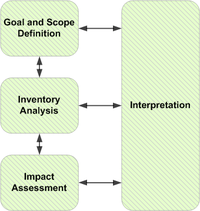
Photo from wikipedia
Abstract The global demand for raw materials is increasing consistently in the modern world such that a resource efficient handling becomes more and more important in today’s manufacturing processes. Therefore,… Click to show full abstract
Abstract The global demand for raw materials is increasing consistently in the modern world such that a resource efficient handling becomes more and more important in today’s manufacturing processes. Therefore, re-manufacturing of degraded products and components is a major step within a sustainable manufacturing strategy. This paper shows an approach to evaluate and to compare the sustainability of two manufacturing processes using life-cycle assessment on the one hand and efficiency analysis methods on the other. In a first step, the two processes were analysed regarding their environmental impact in 13 different effect categories using the life-cycle assessment software GaBi. Data envelopment analysis (DEA) as well as TOPSIS were utilized to evaluate and to compare these results regarding sustainable efficiency in a second step. The analysis is done within the case study “Recycling of lead anode”. The evaluation of a new developed concept for an automated process, in comparison to a manual process, to recycle lead anodes, which were subjected to heavy wear during the electrowinning process of non-ferrous metals like copper, nickel or zinc, is in focus.
Journal Title: IFAC-PapersOnLine
Year Published: 2019
Link to full text (if available)
Share on Social Media: Sign Up to like & get
recommendations!